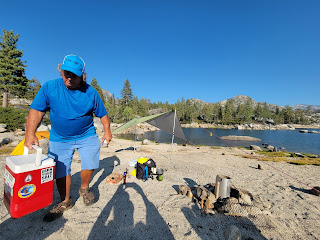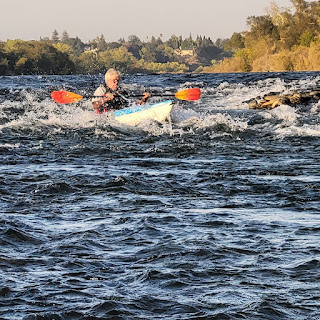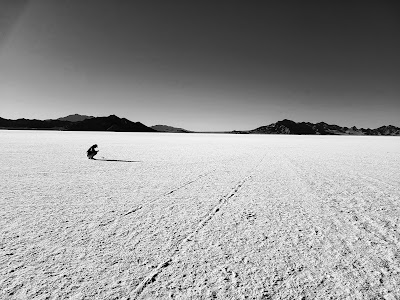When the winds from the North don't venture forth.
Back in the Midwest, I never really got used to the wind. It was somewhere between an icy blast from the North. It's a tornadic rage from the west or a fiery blow torch from the South. Cool breezes were rare, calm days even more. The wind always seemed to be blowing. I can still remember those white-capped Minnesota lakes pushing the boats around.
As a kayaker, the wind is always advantageous. I can tolerate snow. Paddle through the rain on any day.
But it's always those stiff gusty winds that will prove to be the most troublesome. The wind is arguably the biggest environmental factor that can turn my otherwise beautiful kayaking day into a major struggle.
The America Canoe Association, Outdoor Adventures Kayaking book, published in 2009, says that the wind, particularly in touring and sea kayaking, where the paddler is exposed to large expanses of open water is usually the biggest factor to be concerned with. The instructional resource book says, "Wind causes two problems for the kayaker. First, a wind coming from any direction, except head-on, tends to weathervane the boat, sweeping it sideways toward the destination. This not only throws the boater off course but also makes the kayak feel less stable since it is being pushed sideways across the water."
The book went on to say what every experienced paddler already knows. Headwinds can quickly tire you out and make that destination you are heading for seem to take forever to get to. While a good tailwind can be a paddler's friend as long as the winds continue to blow in the direction you are traveling.
The wind is what makes waves. The unobstructed length of water over which wind can blow is called "Wind Fetch." The strength of the wind and the time it blows over the open water will determine the height of waves. The highest energy waves will form where there is a long expanse of unblocked water and sustaining high winds. So yes, kayaking can certainly be a wonderful experience on a lake like Lake Tahoe, but with some 22 miles of "Fetch" it can also be a tiger when the afternoon winds come up pushing large waves.
So, while the not the ocean, big lakes can have winds over 10-mph be dramatically change paddling conditions and change your relaxing experience into a Peloton workout in no time. Our Sierra foothills lakes can often be accompanied by a stiff westerly afternoon wind requiring some intermediate boating skills to take on the rough and choppy lake swells. Over the years, I've learned many of my favorite paddling lakes consistence bad habits of strong gust beginning in the late morning and continuing throughout the day but eventually dying down towards evening.
Plan your kayak routes and canoes around the expected wind patterns in your area. Mornings and evenings are best for excursions to avoid those breezy gusts of the afternoon that will make your paddling day and anyone you like to paddle with much easier.
But while nobody wants to paddle into a headwind, it can be an exhilarating exercise.
"If the waves are rolling and you are forced to make your way against them, there is the joy of battle," writes canoe guru Sigurd Olson, "Each comber an enemy to be thwarted, a problem in approach and defense."
I can share a bit of Olson's glee. But only for a little while. I prefer dodging the gust and waves and seeking protection along the calmer shore and around islands blocking the strong gusts and fighting the wind for shorter periods of short distances. At least, that is always my plan when the wind comes up.
 |
| Lake Comanche |
California's Camanche Reservoir, located east of Lodi, was named after the gold-mining town of Camanche built-in 1849, referring to the fierce southern plains' native American tribe by the same name. The town, now long gone at the bottom of the lake, is only a memory. But on breezy days, the waterway can live up to its fierce namesake when the northern winds toss whitecaps over the lake.
John Taylor and I have battled strong winds before. Both on the Sierra high Loon Lake and even on those blustery days on Lake Natoma. We've struggled to keep our group together on foothills finger Lake Clementine when the afternoon wind picked up. I have had to help a couple of tired paddlers back to the access by towing them along.
It was choppy when we started out on Lake Comanche. We headed out across the broad expanse of the lake from one of the many accesses of the Camanche Recreation Company campground and day-use area. We paddled to the east and found protection in the narrows of the lake. The high cliffs along the lake's east shores resemble a mini–Grand Canyon experience with tall multicolored rock formations on each side of us. After the narrows, we paddled into an area of grassy beaches called China Gulch, where we enjoyed wildlife views of eagles and otters.
Knowing the winds were picking up, we did not dare go further. Turning back into the wind, we knew it would be a battle to return to an even further access point where our truck was parked. When average wind speeds begin to climb into the 15 to 20 mile per hour range, that is when it’s time to get off the water. Anything above 20 miles per hour starts to become downright dangerous. We didn't know if it was blowing 10, 15, or even, 20 mph. All we knew was it was time for plan B. We needed to get off the lake as soon as possible.
Most lake paddlers start and finish at the same location. But wind can derail that plan. So, if you even have the slightest inkling that heavy winds could hamper your return, make sure you identify one or two other shoreline locations where you can land your craft if you can’t make it back to your starting location. There is no reason to tough it out, out there. Always think safety first.
I set my sights on a point on the other side of the lake. It was an island in high water, A peninsula when the lake is low. Either way, it would be our alternate landing.
The wind and waves seemed to push us backward as we slowly paddled toward the peninsula. John in canoe trailed behind became a tiny yellow speck slipping over the tops of the whitecaps. As we all know, canoes sit a bit higher in the water and are a little more wind prone than kayaks. John was in a real battle against nature.
"The beast's claws scraped at the sky from the water below," wrote Natalie Warren in her book Hudson Bay Bound about the lashing waves of Lake Winnipeg," The large swells grew taller and sharper, threatening to crest and crash with each peak. If we swamped here, we would be trouble."
I felt the same as bounded over the waves. Using shorter and more frequent strokes into the headwind, was considerably more tiring. Paddle, paddle. Maneuvered some more big waves, and I tried to look behind me to check on John's process.
It was to my relief that I finally made it across the lake to a safely protected cove. First, I could rest. And second, I could check on John. He and his canoe had been pushed off track, but he was making steady progress across the lake. But we were not done yet.
The peninsula is connected to the mainland by a strand of hardpack mud covered with an overgrowth of weeds. My paddling guidebook said it was about 80 feet portage. It proved to be much further.
Still, it was much faster and less exhausting than paddling all the way around against the wind. After our portage, we had to paddle another short distance in the wind, before coming to our alternate landing. And it was just our luck that a friendly camping couple was there and offered us a ride to our truck.
Nobody likes to paddle into a headwind. It’s always best to have that wind to your advantage as you paddle back toward your starting location. There is satisfaction in reaching any point on the lake map despite the wind and waves. Because, at the end of the day, when the wind finally dies. Though my muscles were sore, I still reveled in my day on the water.
Keep up with Outside Adventure to the Max, on our Facebook page and Instagram, and now on Youtube.























































